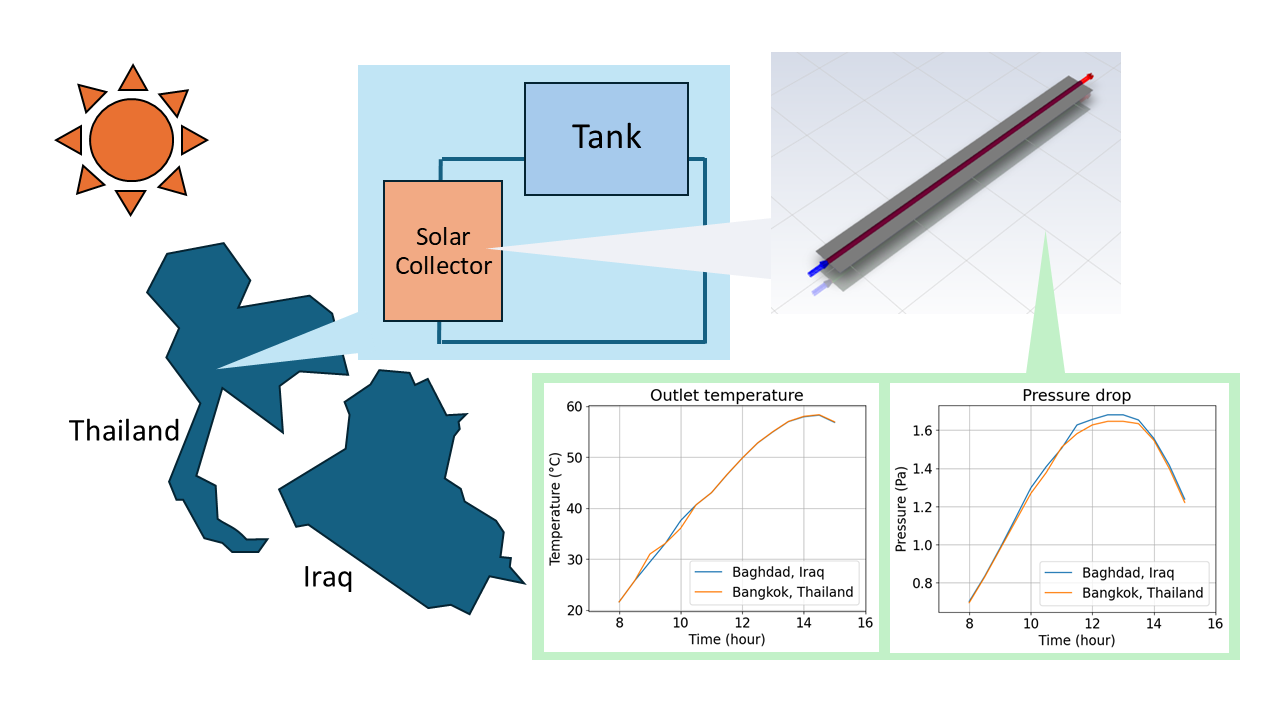Study of Solar Collector Potential in Thailand Using Computational Fluid Dynamics Approach
Main Article Content
Abstract
Due to the proximity of Thailand being near the equator, there is a significant potential for harnessing an excess amount of solar energy using a solar collector. The solar collector harvests solar energy by acting as a passive heat exchanger, receiving solar energy, and transferring it to a fluid medium to be further utilized. This study presents the analysis of temperature outlet and pressure drop of a solar collector in Thailand, utilizing Earth’s geological location, date, and time for solar energy calculations and employing computational fluid dynamics (CFD) to predict the collector’s efficiency. The CFD approach offers a reduction in the cost of experiments and environmental impact by minimizing waste from constructing experimental prototype equipment. A closed loop solar collector for a water heater system with the width of 100 mm and the length of 1,000 mm made with copper is selected for this study. The boundary conditions of the model are collected from the experimental data to ensure high accuracy during the validation process. The grid independence is done to ensure high accuracy simulation with CFD. The study also compares the collector performance with another geological location and with different water mass flow rates in the range of 0.554 to 2.582 g s-1. The results confirm the potential of solar collectors in Thailand by achieving efficiency an of 69.61% at 11 a.m. with 2.332 g s-1of mass flow rate.
Article Details

This work is licensed under a Creative Commons Attribution-NonCommercial 4.0 International License.
Published articles are under the copyright of the Applied Environmental Research effective when the article is accepted for publication thus granting Applied Environmental Research all rights for the work so that both parties may be protected from the consequences of unauthorized use. Partially or totally publication of an article elsewhere is possible only after the consent from the editors.
References
Anderson, T.R., E. Hawkins, and P.D. Jones, CO2, the greenhouse effect and global warming: from the pioneering work of Arrhenius and Callendar to today's Earth System Models. Endeavour, 2016. 40(3): p. 178-187.
Yuan, Z., M.R. Eden, and R. Gani, Toward the Development and Deployment of Large-Scale Carbon Dioxide Capture and Conversion Processes. Industrial & Engineering Chemistry Research, 2016. 55(12): p. 3383-3419.
Tian, Y. and C.Y. Zhao, A review of solar collectors and thermal energy storage in solar thermal applications. Applied Energy, 2013. 104: p. 538-553.
Verma, S.K., A.K. Tiwari, and D.S. Chauhan, Experimental evaluation of flat plate solar collector using nanofluids. Energy Conversion and Management, 2017. 134: p. 103-115.
Janjai, S., J. Laksanaboonsong, and T. Seesaard, Potential application of concentrating solar power systems for the generation of electricity in Thailand. Applied Energy, 2011. 88(12): p. 4960-4967.
Kalogirou, S., Thermal performance, economic and environmental life cycle analysis of thermosiphon solar water heaters. Solar Energy, 2009. 83(1): p. 39-48.
Alkhafaji, M.H., B. Freegah, and M.H. Alhamdo, Study the influence of adding fins to the plate of the solar collector on thermal performance under natural phenomena. International Communications in Heat and Mass Transfer, 2022. 135: p. 106058.
Farajzadeh, E., S. Movahed, and R. Hosseini, Experimental and numerical investigations on the effect of Al2O3/TiO2H2O nanofluids on thermal efficiency of the flat plate solar collector. Renewable Energy, 2018. 118: p. 122-130.
Razika, I., et al., The effects of volumetric flow rate and inclination angle on the performance of a solar thermal collector. Energy Conversion and Management, 2014. 78: p. 931-937.
Worapan Kanchanachat and S. Janjai, A study of monthly average daily global solar radiation from measuring stations in Thailand, in Department of Physics. 2021, Silpakorn University.
Stanciu, C. and D. Stanciu, Optimum tilt angle for flat plate collectors all over the World – A declination dependence formula and comparisons of three solar radiation models. Energy Conversion and Management, 2014. 81: p. 133-143.
Duffie, J.A., Beckman A. William, Blair Nathan, Flat-Plate Collectors, in Solar Engineering of Thermal Processes. 2013. p. 236-321.
Gunjo, D.G., P. Mahanta, and P.S. Robi, CFD and experimental investigation of flat plate solar water heating system under steady state condition. Renewable Energy, 2017. 106: p. 24-36.
Jasim, A.K., B. Freegah, and M.H. Alhamdo, Numerical and experimental study of a thermosyphon closed-loop system for domestic applications. Heat Transfer, 2021. 50(1): p. 292-312.
Yildizhan, H., T.A. Cheema, and M. Sivrioglu, The effect of the intermediate fluid-flow rate on the system performance in the closed circuit applications of the solar collector. Thermal Science, 2021. 25(2 Part A): p. 1181-1191.
Abo-Elfadl, S., H. Hassan, and M.F. El-Dosoky, Study of the performance of double pass solar air heater of a new designed absorber: An experimental work. Solar Energy, 2020. 198: p. 479-489.
Wang, N., et al., Numerical study of flat plate solar collector with novel heat collecting components. International Communications in Heat and Mass Transfer, 2015. 69: p. 18-22.

